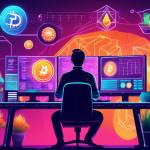Understanding the Risks and Rewards of Crypto Leverage Trading What is Crypto Leverage Trading? A…
Exploring the Intersection of Crypto Trading and NFTs

In the rapidly evolving world of digital assets, the intersection of crypto trading and NFTs represents a groundbreaking frontier teeming with potential and innovation. As blockchain technology continues to gain traction, understanding both crypto trading and NFTs becomes increasingly crucial. Crypto trading involves the buying, selling, and exchanging of cryptocurrencies like Bitcoin and Ethereum, leveraging the decentralized and secure nature of blockchain. NFTs, or Non-Fungible Tokens, are unique digital assets that certify ownership of a specific item or piece of content via blockchain, ensuring rarity and indivisibility. Both crypto trading and NFTs have seen a meteoric rise in popularity due to their disruptive capabilities and the array of opportunities they present.
Exploring the intersection of crypto trading and NFTs holds significant importance for several reasons. Firstly, both sectors offer immense financial and investment potential, attracting a growing number of individuals and institutional players. Secondly, the innovation at this intersection is driving the creation of new marketplaces and platforms, such as NFT-focused crypto exchanges. Additionally, as blockchain technology underpins these markets, the advantages of decentralization, such as enhanced security and transparency, can be fully leveraged.
This comprehensive exploration will delve into how blockchain technology powers and influences both crypto trading and NFTs, providing insights into decentralization’s benefits. By examining successful case studies, we can understand the practical applications and impacts of blockchain in these domains. Furthermore, the article will uncover the opportunities that lie at this intersection, highlighting the investment potential, emerging marketplaces, and innovative trends. However, it also considers the challenges and future outlook, discussing regulatory hurdles, market volatility, technological barriers, and predicting future trends.
By navigating the intricate landscape where crypto trading and NFTs converge, readers will gain a detailed understanding of the current state and future possibilities of these transformative digital markets.
Definition and Overview of Crypto Trading
Crypto trading involves the buying and selling of cryptocurrencies in various markets, similar to how conventional stocks are traded. It leverages the volatility and trends within digital currencies to generate profit. Key cryptocurrencies include Bitcoin (BTC), Ethereum (ETH), and countless altcoins. Crypto trading can be categorized as:
- Spot Trading: This involves immediate buying and selling of cryptocurrencies at current market prices.
- Margin Trading: Traders borrow funds to trade larger positions, amplifying potential gains and losses.
- Futures Trading: Buying and selling contracts that represent the value of a specific cryptocurrency at a future date.
Crypto trading occurs on various exchanges like Binance, Coinbase, and Kraken, each providing different features, trading pairs, and user experiences.
Understanding NFTs and Their Unique Attributes
Non-fungible tokens (NFTs) are unique digital assets stored on a blockchain, primarily the Ethereum network. Unlike fungible assets like Bitcoin or fiat currencies, NFTs are one-of-a-kind and irreplaceable, representing ownership of digital or physical items. Key attributes include:
- Uniqueness: Each NFT has a distinct identifier, making it distinct from other tokens.
- Indivisibility: NFTs cannot be divided into smaller units and must be purchased or sold as whole items.
- Provenance: Blockchain technology ensures the provenance and authenticity of NFTs, tracing ownership history.
- Interoperability: NFTs can be used across various applications and platforms within the blockchain ecosystem.
Examples of NFTs include digital art, virtual real estate, and collectibles like CryptoPunks or Bored Ape Yacht Club. The concept extends to other domains such as music, gaming, and even event tickets.
The Growing Popularity of Crypto Trading and NFTs
The popularity of crypto trading and NFTs has skyrocketed over the past few years. Several factors contribute to this growth:
- Increased Institutional Interest: Institutions and notable investors are increasingly participating in crypto markets, lending credibility and attracting retail investors.
- Mass Adoption: Growing awareness and acceptance of cryptocurrencies and blockchain technology drive mainstream adoption.
- Technological Advancements: Innovations in blockchain technology enhance scalability and security, making crypto trading and NFTs more accessible.
- Pandemic Effect: The COVID-19 pandemic accelerated digital transformation and interest in alternative investments, contributing to the rise of digital assets.
- Social Media Hype: Influencers and celebrities endorsing crypto and NFTs help fuel demand and market engagement.
For instance, NFT marketplaces like OpenSea and Rarible have seen explosive growth in the trading volume of digital collectibles and art, while crypto exchanges continue to expand their user base and services.
Importance of Exploring Their Intersection
The intersection of crypto trading and NFTs presents a unique and compelling opportunity within the digital economy. Understanding this convergence is crucial for several reasons:
- Investment Diversification: Combining crypto trading strategies with NFT investments can diversify portfolios, mitigating risks associated with volatility.
- Enhanced Market Liquidity: The integration of NFTs into traditional crypto markets can enhance liquidity, making it easier to buy, sell, and trade digital assets.
- Innovative Financial Instruments: The fusion can give rise to new financial products, such as NFT-backed tokens or fractional ownership opportunities.
- Broader Market Utility: NFTs can revolutionize sectors beyond art, including real estate, music, sports, and tickets, providing broader utility and driving further adoption of crypto trading.
By exploring the intersection between crypto trading and NFTs, market participants can leverage synergies to maximize potential returns and participate in shaping the future of digital asset marketplaces.
For further understanding and insights, visit resources such as CoinDesk and The Block to stay updated on the latest trends in crypto trading and NFTs.

The Role of Blockchain Technology in Crypto Trading and NFTs
How Blockchain Powers Crypto Trading
Blockchain technology serves as the backbone for crypto trading by providing a decentralized ledger that records all transactions. This removes the need for intermediaries like banks, making transactions faster, cheaper, and more transparent. Here’s how blockchain specifically empowers crypto trading:
- Security: The use of cryptographic algorithms ensures that transactions are secure and immutable.
- Transparency: Every transaction is recorded on a public ledger, providing full transparency to participants.
- Efficiency: Eliminating intermediaries reduces transaction times and lowers costs.
- Accessibility: Anyone with an internet connection can participate in crypto trading, democratizing financial opportunities.
Blockchain’s Impact on the Creation and Exchange of NFTs
Non-fungible tokens (NFTs) revolutionize digital ownership, and blockchain technology lies at the heart of this transformation. Here’s how blockchain influences the creation and exchange of NFTs:
- Authenticity: Each NFT contains unique information stored on the blockchain, verifying its rarity and authenticity.
- Ownership: Blockchain enables transparent and verifiable ownership transfers, ensuring that provenance is easily tracked.
- Smart Contracts: These are self-executing contracts with terms directly written into code, facilitating seamless transactions without intermediaries.
- Interoperability: NFTs can be traded across multiple platforms and marketplaces, thanks to standardized blockchain protocols like ERC-721 and ERC-1155.
The Advantages of Decentralization in Both Markets
Decentralization is a core principle driving both crypto trading and NFTs, offering several compelling advantages:
- Reduced Risk of Fraud: With transactions verified by a decentralized network, the chances of fraud are significantly reduced.
- Enhanced Privacy: Users can remain pseudonymous, protecting their personal information while transacting.
- Lower Costs: By cutting out intermediaries, users benefit from reduced fees and transaction costs.
- Global Access: Anyone around the world can participate, fostering an inclusive financial ecosystem.
Case Studies Highlighting Successful Blockchain Utilization
To better understand the effectiveness of blockchain in crypto trading and NFTs, let’s look at some notable case studies:
1. Binance
As one of the world’s largest crypto exchanges, Binance leverages blockchain to offer a secure and efficient trading platform. Its decentralized exchange, Binance DEX, allows users to trade cryptocurrencies with complete control over their funds.
2. OpenSea
OpenSea is a leading NFT marketplace that utilizes blockchain to facilitate the buying, selling, and discovering of digital assets. The platform supports various blockchains, ensuring interconnectivity and broad access to NFTs.
3. CryptoKitties
CryptoKitties, one of the first blockchain-based games, showcases the potential of NFTs. Each virtual cat is an NFT, proving blockchain’s applicability beyond financial transactions into entertainment and collectibles.
4. Uniswap
Uniswap is a decentralized trading protocol built on Ethereum that highlights the power of blockchain in eliminating intermediaries, offering liquidity pools, and enabling direct peer-to-peer trading.
Through these case studies, it’s clear that blockchain technology is not only integral to the foundational operations of crypto trading and NFTs but also presents innovative opportunities for future applications. The decentralized nature of blockchain continues to disrupt traditional systems, paving the way for a more inclusive and efficient digital economy.

Opportunities at the Intersection of Crypto Trading and NFTs
Investment Potential and Financial Opportunities
As the worlds of crypto trading and NFTs come together, investors stand to gain significantly from this burgeoning ecosystem. The merging of these two domains has created avenues for remarkable financial growth. Here are several reasons why investment opportunities are burgeoning:
- Portfolio Diversification: Crypto trading and NFTs offer unique ways to diversify investment portfolios. While crypto assets can be highly liquid, NFTs provide ownership of digital assets.
- High Returns: Early adopters can potentially reap substantial returns, as both markets have shown significant appreciation in value over relatively short periods.
- Access to New Markets: By engaging with NFTs, crypto traders tap into markets like digital art, gaming, and virtual real estate, broadening their investment horizons.
For a comprehensive guide on maximizing investment potential in crypto and NFTs, check out this Investopedia article.
The Emergence of NFT Marketplaces and Crypto Exchanges
The intersection of crypto trading and NFTs has spurred the development of specialized platforms tailored to traders and investors.
- NFT Marketplaces: Platforms like OpenSea, Rarible, and Foundation facilitate the buying, selling, and minting of NFTs. These marketplaces offer easy access to digital assets for both creators and collectors.
- Crypto Exchanges: Leading exchanges such as Binance and Coinbase are integrating NFT functionalities, enhancing liquidity and providing new financial instruments for traders.
- Interoperability: Cross-platform functionalities are being developed, allowing assets to move seamlessly between different ecosystems, which enhances market efficiency.
To explore the top NFT marketplaces, visit The Block.
Trends and Innovations in the Crypto-NFT Space
The crypto-NFT space is continuously evolving, driven by innovation and technological advancements. Several key trends are shaping its future:
- Gamification: The integration of NFTs in gaming has led to the rise of play-to-earn models, where players earn crypto assets through gameplay.
- Fractional Ownership: Platforms now allow investors to purchase fractions of high-value NFTs, democratizing access to expensive digital assets.
- Metaverse Integration: Virtual worlds like Decentraland and The Sandbox incorporate NFTs for virtual land ownership and in-game assets, creating entire ecosystems within the metaverse.
For a deep dive into the latest trends in crypto-NFTs, refer to this CoinDesk article.
Real-World Applications and Use Cases
The intersection of crypto trading and NFTs is also paving the way for practical applications that extend beyond purely financial opportunities:
- Art and Collectibles: Artists can tokenize their work, ensuring authenticity and earning royalties on secondary sales, exemplified by platforms like SuperRare.
- Music and Entertainment: Musicians and content creators leverage NFTs to monetize their work directly from fans, bypassing traditional distribution networks. Kings of Leon’s NFT album release exemplifies this model.
- Real Estate: Digital real estate in virtual worlds allows investors to own and trade parcels of land, while smart contracts in physical real estate can streamline transactions.
For more insights on real-world applications, visit this Forbes article.
The fusion of crypto trading and NFTs is creating unprecedented opportunities across various sectors. By staying informed and leveraging these emerging trends, investors and enthusiasts can capitalize on the potential that lies at the intersection of these dynamic markets.

Challenges and Future Outlook for Crypto Trading and NFTs
Regulatory and Security Concerns
Crypto trading and NFTs bring a raft of regulatory and security challenges that can dampen their potential. Governments worldwide are struggling to create comprehensive regulations that can effectively govern these new-age financial instruments without stifling innovation.
- Regulatory Uncertainty: Different countries have varying stances on crypto assets, ranging from outright bans to favorable regulations. This inconsistency creates confusion and hinders global adoption.
- KYC/AML Compliance: Know Your Customer (KYC) and Anti-Money Laundering (AML) regulations are essential for avoiding illicit activities. While many crypto exchanges and NFT platforms require KYC, there is still a significant portion that operates with little to no regulations, causing security risks.
- Intellectual Property Issues: NFTs often represent digital assets like artwork or music. Determining ownership and enforcing intellectual property rights in an easily duplicable digital environment remains a complicated issue.
For more on regulatory challenges, visit CoinDesk Regulation.
Volatility and Market Fluctuations
The volatile nature of crypto trading and NFTs could be a deterrent for many potential investors. The value of cryptocurrencies and NFTs can surge and plummet in rapid succession, leading to significant financial risks.
| Factor | Description |
|---|---|
| Market Sentiment | News, social media trends, and public opinion can drastically influence the value of cryptocurrencies and NFTs. |
| Speculative Trading | Futures and derivative markets in crypto trading can lead to increased speculation, impacting prices significantly. |
| Scalability Issues | As both crypto and NFT platforms grow, scalability issues can affect transaction speed and costs, leading to unstable market behavior. |
Understanding market volatility is crucial for success. For more insights on market trends, check out Investopedia on Cryptocurrency Market.
Technological and Adoption Barriers
Despite growing interest, several technological and adoption barriers hinder the mainstream acceptance of crypto trading and NFTs. These challenges must be addressed to unlock the full potential of these markets.
- Technical Complexity: Many people find crypto assets and NFT transactions too complicated. User-friendly platforms and comprehensive education are vital for wider adoption.
- Interoperability: Different blockchain networks often do not communicate effectively with one another. Enhancing interoperability can streamline transactions and increase usability.
- Environmental Concerns: The environmental impact of blockchain mining processes, particularly in proof-of-work systems, is a growing concern. More sustainable methods are essential.
Technological advancements are critical for overcoming these barriers. For further reading on blockchain technology, visit IBM Blockchain.
Predictions and Future Trends in Crypto Trading and NFTs
Despite challenges, the future outlook for crypto trading and NFTs is promising. Industry experts predict several trends and developments that could shape the future landscape.
- Institutional Investment: As regulations become clearer, more institutional investors are likely to enter the crypto and NFT markets, bringing greater liquidity and stability.
- Continuous Technological Innovations: Emerging technologies like Layer 2 scaling solutions, green energy mining, and enhanced cryptographic methods are expected to address current barriers and improve usability.
- Integration with Traditional Financial Systems: Improved interoperability between traditional banking systems and crypto markets will facilitate smoother transactions and broader acceptance.
- Expansion of Use Cases: Beyond digital art, NFTs may find applications in domains like real estate, intellectual property, and supply chain management.
To stay updated on future trends, visit Crypto News Trends.
In conclusion, the dynamic intersection of crypto trading and NFTs offers a fascinating glimpse into the future of digital assets and their numerous possibilities. Both crypto trading and NFTs are underpinned by blockchain technology, which not only ensures transparency and security but also fosters innovation across these digital landscapes. Crypto trading has rapidly evolved, providing investors with new avenues for wealth generation and financial diversification, while NFTs have emerged as unique digital assets that encapsulate ownership and provenance like never before.
Blockchain technology plays a crucial role in both arenas, enabling decentralized transactions that are secure and immutable. This decentralization mitigates the risks associated with centralized systems, empowering users with greater control over their assets. Successful utilization of blockchain is evident in various case studies where it has enhanced the efficiency and trustworthiness of crypto exchanges and NFT platforms alike.
Opportunities at this intersection are vast. Investors are increasingly recognizing the potential of integrating NFTs within their crypto portfolios, capitalizing on the evolving trends and financial prospects. The rise of NFT marketplaces and crypto exchanges has streamlined the buying, selling, and trading processes, further boosting market growth. Innovations such as fractional ownership of NFTs, DeFi NFT projects, and cross-chain interoperability are paving the way for more inclusive and versatile digital economies. Moreover, NFT applications are expanding beyond art and entertainment into real estate, gaming, and identity verification, signifying their growing utility and relevance.
However, challenges persist. Regulatory uncertainties and security concerns pose significant risks, requiring ongoing vigilance and adaptation from stakeholders. Market volatility remains a deterrent for some, as price fluctuations can lead to substantial financial losses. Additionally, technological impediments and slow adoption rates underscore the need for continuous development and education to demystify these complex technologies for the wider public.
Looking ahead, the synergy between crypto trading and NFTs is poised to reshape the digital asset landscape. Enhanced regulatory frameworks and technological advancements will likely spur growth and adoption, while fostering a more secure and stable environment for transactions. As these markets mature, the transformative potential of integrating NFTs into the broader crypto universe will become increasingly apparent, unlocking new realms of innovation and utility.





